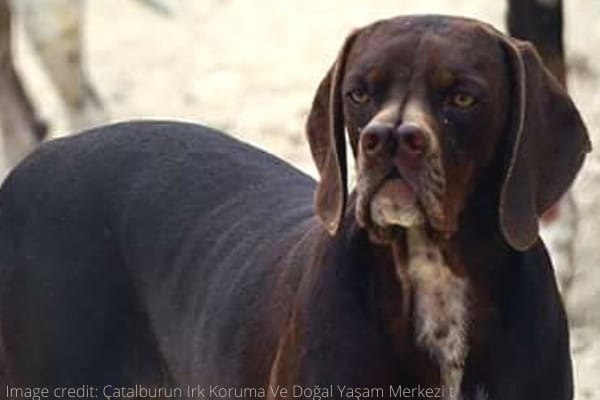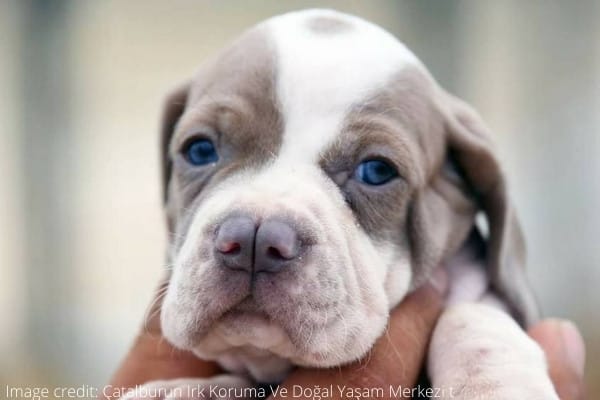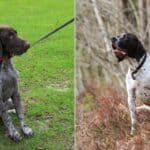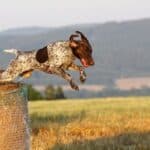
If you aren’t familiar with this rare pointing breed, you’re not alone.
As one of the rarest hunting dogs in the world, the Catalburun doesn’t receive a lot of attention, despite being one of only three breeds to possess a split nose.
In fact, outside of his homeland of Turkey, the dog is practically entirely unknown.
However lacking in recognition this breed may be, it is still an extremely interesting hunting dog and well worth checking out.
What is a Catalburun? The Catalburun, or Turkish Split Nose Pointer, is a rare pointing breed found almost exclusively in the Tarsus region of Turkey. The Catalburun has a distinctive nose in which the nostrils are separated by a deep groove, leaving the nose looking as if it has been split in two.
Of course, many dog breeds can be considered not very common and/or difficult to find. However, in the case of the Turkish Split Nose, being termed rare is almost an understatement.
If you’re at all like me, you find rare and unusual dogs to be fascinating. Rest assured – Catalburuns won’t disappoint.
In fact, due to incredibly low numbers, this breed is one of the rarest in the world today.
The Catalburun (Tarsus Fork Nose Dog): Breed Facts
The Catalburun is a dog of many names. In Turkey he is simply called a Catalburun from the Turkish words catal (fork or split) and burun (nose).
Elsewhere, the following names are frequently used:
- Tarsus Catalburun.
- Tarsus Fork Nose Dog.
- Turkish Pointer.
- Turkish Split Nose.
- Split Nose Pointer.
- Split Nose Dog.
- Fork Nose Dog
- Turkish Split Nose Pointer.
- Double Nose Dog.
All of these names refer to a pointing breed, the Catalburun, unique to the city of Tarsus in the province of Mersin in Turkey.
(Does Tarsus ring a bell? It was the birthplace of St. Paul the apostle circa 4 BC.)
It is commonly believed that several Pachón Navarro dogs were brought to the region by Spaniards in the 1700s and they eventually, over many years, developed into a new breed.
Other theories about the breed’s origin exist, but this one seems to be the most plausible, especially given the similarities in movement, temperament, appearance, and hunting style of the Pachón Navarro and the Catalburun.
Estimations put the breed’s current population at 200 individuals, and the numbers have been quite low for some time, meaning that inbreeding, whether intentional or accidental, has been an ongoing problem.
Despite the high occurrence of inbreeding, Catalburuns seem to lack major health concerns that are so prevalent in more common breeds.
Though they are generally healthy, they may on occasion suffer from hip dysplasia, hypothyroidism, and various allergies.
Appearance
At first glance, the Turkish Catalburun appears quite similar to more common pointing breeds, such as the English Pointer or German Shorthaired Pointer (learn more here).
However, this breed is far from common, and a closer inspection of the dog’s face quickly reveals his utter uniqueness.
Body
Catalburuns stand approximately 18-20 inches tall at the withers and have an average body length of around 21 inches.
There is a slight downward slope from the withers to the rump, with the rump positioned an inch or two lower than the shoulders when viewed from the side.
Weight ranges from 35-55 pounds. In most instances, males are both taller and heavier than their female counterparts.
Overall, Catalburuns have a sleek, muscular frame with a deep chest and long, sturdy legs.
This enables them to maneuver quickly, efficiently, and smoothly when in the field. The tail is long, slender, and slightly curved.
Broad foreheads and long muzzles are standard in the breed. The eyes are a shade of brown at maturity, oval in shape, and bright and alert.
The triangular ears are folded down and long, usually hanging down past the jawline.
Coat
Split-Nose Pointers have a short, smooth, single coat to permit them to hunt in various terrain without difficulty.
While more than 50% of Catalburuns are brown in color, the brown can vary greatly, ranging from tan to a rusty-like red to a dark chocolate color.
Black is also seen in the breed, though not as commonly (roughly 9% of the dogs). Bicoloration is common, and tricolor patterns are possible as well.
Nose

The rare split nose, known as a bifid nose, is truly what sets this breed apart.
While all dogs have a slight, narrow depression visible between the two nostrils, the Catalburun has a deep cleft running from the top of the nose all the way down to where the nose meets the upper lip.
This results in the nose being completely split in half. This bifid nose is often described as resembling a double-barrel shotgun.
In some Catalburun dogs, a shallow cleft appears to continue under the skin from the nose all the way over the top of the head.
Some believe that the unusual nose structure enables them to smell better, though there is no hard evidence that this is indeed the case.
Two other dog breeds, the Pachón Navarro and the Andean Tiger Hound, also frequently have a bifid nose, but the Turkish Pointer always has a split nose, further setting him apart.
Temperament
Like other dogs, the Catalburun’s temperament is greatly influenced by the way in which he is raised.
Generally speaking, however, the breed is said to be friendly toward family members, rather aloof with strangers, and protective of their territory.
Depending on previous experiences, he may or may not get along well with other dogs.
Traditionally kept as outside dogs in their homeland, Catalburuns take naturally to guarding their property and family, quietly remaining diligent in their role.
They will bark when necessary, but because of the fact that they were bred to quietly stalk and point prey, they are relatively quiet and calm by nature.
Energy Level
The Turkish Split Nose Pointer has a high energy level, as do most dogs bred to hunt. Their muscular bodies allow them to be fast and agile, and they love to run freely.
When not provided with the opportunity to run and burn off their energy stores, they are likely to become frustrated, and bad behavior is likely to result.
In addition to working their bodies, it is equally important that these intelligent dogs are routinely given the chance to exercise their minds by doing what they were born to do – track and point partridges.
Hunting Ability
In their native land of Turkey, Catalburun Split Nose Dogs are used extensively as scent-hounds to hunt for partridge.
They are prized for their stamina and ability to hunt silently, efficiently, and independently. They are quick and adept in the field and are said to have an incredible sense of smell.
In their home vicinity, their ability to detect scents has recently led the breed in a new direction.
Although they are still used for hunting partridge and likely other small prey birds, they are now also being used by local police to sniff out illegal drugs and explosives and to track down lost or missing people.
The Future of this Rare Breed

Considering that only about 200 true Catalburuns exist today, the outlook for the breed looks grim. There are several reasons for this:
- Very, very few Catalburuns exist outside of Turkey.
- In their native land, Catalburuns account for only 0.015% of the total dog population.
- There is no official breed standard.
- Catalburun dogs are not recognized by any major dog breed clubs or organizations.
- Outside of Turkey, knowledge of and interest in the breed is quite low.
- Inbreeding has been occurring for a number of years.
Although the odds appear to be stacked against this pointing breed, all hope is not lost.
According to Tekdeeps, breed enthusiasts are undergoing a joint effort at the Turkish Vizsla Reproduction and Rehabilitation Center to test and monitor the purity of the breed.
As of 2020, the purity of the Catalburun breed was 87%.
With continued focused breeding efforts and the cooperation of various animal groups in the country, perhaps the breed will not only survive but will one day thrive again.
Split Noses in Dogs
We’ve seen that bifid, or split, noses occur in three breeds: the Catalburun, the Pachón Navarro, and the Andean Tiger Hound.
However, split noses have been known to occur in several other breeds as well, most notably molosser breeds, such as the Great Dane and Bullmastiff.
In these breeds, a bifid nose is considered to be a genetic defect and is often seen in conjunction with a cleft lip and/or cleft palate.
There is some evidence that points to a reduction of such abnormalities when the mother is given folic acid before and during gestation, but more studies need to be done for conclusive documentation.
So, do dogs with split noses really have a keener sense of smell? Although it is possible, the truth is that no one knows for certain.
It seems more likely that the Catalburun has a highly developed and extremely sensitive sense of smell due to purposeful breeding over the years and simple genetics – not the fact that the nostrils are a few more millimeters farther apart than other breeds.
A Quick Look Back
The Split Nose Dog from Turkey may not be well known, but he certainly is unique.
Although the number of Catalburun dogs right now is scarily low, dedicated efforts are underway to preserve this pointing breed and may lead to a bright future, perhaps one day eventually resulting in full breed recognition and greater world-wide exposure.
For now, let’s remain hopeful and appreciate this truly one-of-a-kind dog.
Credit for images: Çatalburun Irk Koruma Ve Doğal Yaşam Merkezi




